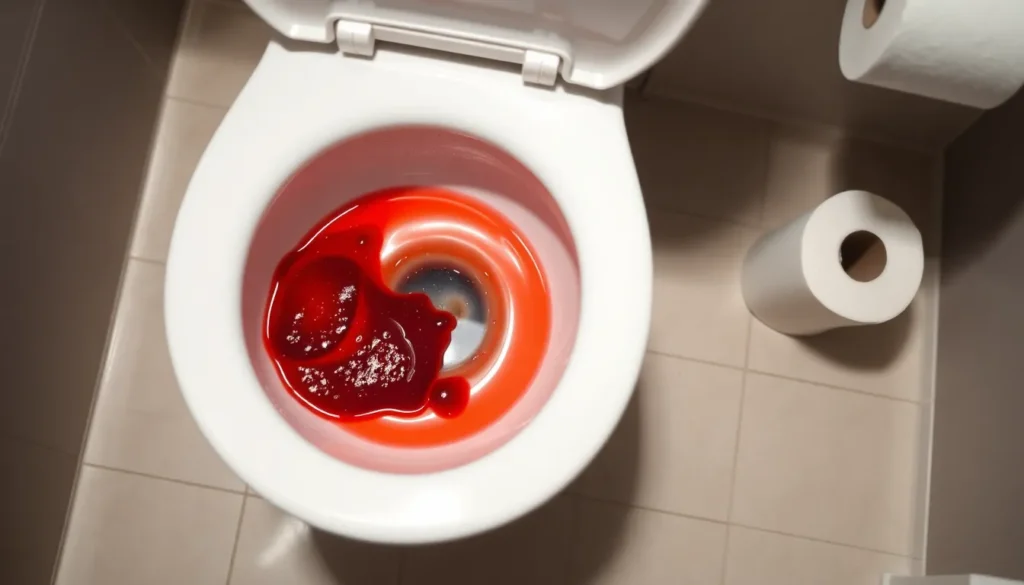When nature calls, the last thing anyone expects is a horror show in the bathroom. But if you ever find yourself staring at a crimson surprise in the toilet, it’s time to pay attention. Bloody stool can be alarming, and understanding what it looks like is crucial for your health. It’s not just a scene from a horror movie; it could be a sign that something’s off in your digestive system.
Table of Contents
ToggleWhat Does Bloody Stool Look Like
Bloody stool presents in various forms, ranging from bright red to dark brown or even black. Bright red blood often indicates fresh bleeding in the lower gastrointestinal tract, likely from conditions like hemorrhoids or anal fissures. Dark brown or black stool may suggest bleeding from higher in the digestive system, such as ulcers or tumors, often leading to tarry feces known as melena.
Observing the color is crucial. For instance, bright red blood may look like streaks on the surface of stool or mixed throughout it. Dark brown stool may appear shiny or sticky, signifying older blood. Identifying the presence of blood can guide individuals to seek medical attention promptly.
Texture also varies. Stool may appear more watery, especially when mixed with blood due to diarrhea or infection. In some cases, bloody stool may additionally be accompanied by mucus, which can signal conditions like inflammatory bowel disease or infections.
Amount of blood plays a significant role. Small amounts might only leave a discoloration, while substantial bleeding can create an alarming visual. Individuals should never dismiss any instance of bloody stool, as it may indicate serious health issues that require immediate evaluation.
Bloody stool can manifest through various colors, textures, and amounts, making it essential to assess these characteristics for appropriate action. Observing these features enables individuals to be proactive about their digestive health.
Types of Bloody Stool

Bloody stool can appear in various forms, each indicating specific health concerns. Observing these differences offers insight into potential underlying issues.
Bright Red Stool
Bright red stool usually signals fresh bleeding from the lower gastrointestinal tract. Common causes include hemorrhoids and anal fissures. Individuals may notice this type of blood coating the surface of the stool or appearing in the toilet water. Prompt evaluation is advisable if bright red stool occurs, as it can indicate a need for medical attention.
Dark Red or Maroon Stool
Dark red or maroon stool arises from bleeding further up in the digestive system. This coloration often suggests conditions like diverticulosis or colonic polyps. Feces may carry a thicker, darker appearance, unlike bright red stool. Observing any changes in stool color is crucial for identifying health issues that require medical assessment.
Black Stool
Black stool typically indicates bleeding from the upper gastrointestinal tract, such as the stomach or small intestine. This discoloration often results from the digestion of blood, making it appear tarry or sticky. Conditions like ulcers or gastritis may lead to this serious symptom. Immediate medical attention is essential when encountering black stool, as it can signify significant internal bleeding.
Causes of Bloody Stool
Various conditions contribute to the occurrence of bloody stool, and understanding the underlying causes can help pinpoint health issues.
Hemorrhoids
Hemorrhoids frequently cause bright red stool, which often indicates fresh bleeding from the lower gastrointestinal tract. Straining during bowel movements, pregnancy, or prolonged sitting increases the risk of developing hemorrhoids. Individuals may notice blood on toilet paper or in the toilet bowl, making this symptom easily identifiable. While hemorrhoids are generally not life-threatening, they require medical attention for comprehensive treatment.
Gastrointestinal Bleeding
Gastrointestinal bleeding encompasses a range of serious conditions that can lead to bloody stool. Ulcers, diverticulosis, and tumors can all result in dark red or black stool, indicating bleeding higher in the digestive system. Symptoms can vary, potentially including abdominal pain, dizziness, or weakness, especially if blood loss is significant. Early diagnosis and treatment are crucial, as untreated gastrointestinal bleeding can lead to severe complications.
Infections and Inflammation
Infections and inflammation can also lead to bloody stool, often accompanied by diarrhea, abdominal cramps, and fever. Conditions such as gastroenteritis or inflammatory bowel disease, including Crohn’s disease and ulcerative colitis, can result in these troubling symptoms. Bacterial infections, like those from E. coli or Salmonella, may present with bloody diarrhea, requiring immediate medical intervention. Identifying the cause of the infection or inflammation proves vital for effective treatment and recovery.
When to Seek Medical Attention
Recognizing the signs of bloody stool can be critical for health. Individuals should seek medical attention immediately if they observe bright red blood mixed with or coating the stool. This symptom often signals fresh bleeding from the lower gastrointestinal tract, commonly due to hemorrhoids or anal fissures.
Dark red or maroon stool may indicate more serious issues. This coloring suggests bleeding from further up the digestive system, potentially linked to conditions such as diverticulosis or colonic polyps. Medical evaluation becomes essential in these cases due to the possible complications.
Black stool presents another concerning sign. Typically, it signals bleeding from the upper gastrointestinal tract, often attributed to severe conditions like ulcers or gastritis. The presence of black stool warrants immediate medical intervention.
In addition to color, certain accompanying symptoms serve as indicators of when to seek help. Individuals experiencing significant abdominal pain or cramping alongside bloody stool should contact a healthcare professional promptly. Severe diarrhea or vomiting may also indicate a serious underlying condition that requires swift evaluation.
Scheduling an appointment becomes crucial if the bloody stool persists over two days. Individuals should also take note of any other symptoms such as weight loss or fatigue, as these can help healthcare providers determine the urgency of the situation.
Prompt medical attention plays a vital role in addressing potential health issues early. Observing the characteristics of bloody stool and any accompanying symptoms can significantly influence treatment outcomes.
Finding bloody stool can be unsettling and should never be ignored. The color and consistency of the blood provide essential clues about the potential source of bleeding within the gastrointestinal tract. Whether it’s bright red indicating fresh bleeding or dark black suggesting more serious issues, recognizing these signs is crucial for timely medical intervention.
Individuals experiencing bloody stool, especially with accompanying symptoms like abdominal pain or weight loss, must seek medical attention promptly. Early evaluation can lead to effective treatment and better health outcomes. It’s vital to stay informed and proactive about digestive health, as addressing concerns early can make a significant difference.









